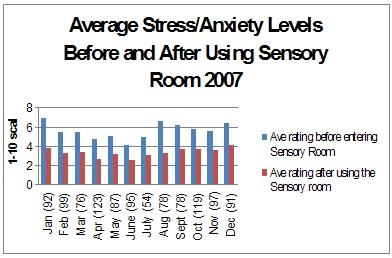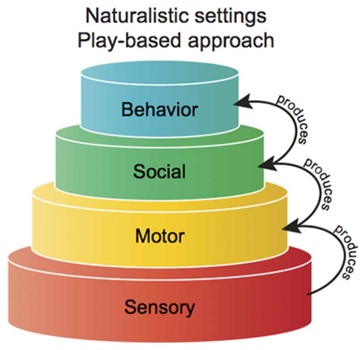
The allure of those picture-perfect sensory rooms on online platforms might stir up feelings of envy. As dedicated professionals in the realm of special education, your primary concern is the well-being and progress of our students. Many of them require added sensory input throughout their daily routines to attain a state of regulation conducive to learning. Even if funds are available and you're in pursuit of the ultimate sensory equipment for your dreamlike sensory haven, read on to explore some inexpensive sensory room ideas to address each sensory system effectively.
What Do You Understand By A Sensory Room?
The basic idea for building sensory rooms is to provide a special room to children with sensory impairment so that they can focus on limited sensory stimuli. In simple terms, rather than being constantly bombarded by jarring sounds and disjointed visuals, a student in the sensory rooms can focus just on the glowing objects or bubble tube.

The sensory room has multiple sensory components from calming music to optic light strands and includes things like hammock swings or ball pits to include movement and touch. These multi-sensory experiences usually are very focused and have a common goal of preventing students from becoming anxious or overwhelmed. Sensory rooms also often have sensory stations where learners can concentrate on one activity at a time.
7 Sensory Room Ideas Within A Budget To Cater To Every Learner Style
If you are unsure about what to include in your sensory room, here are some ideas to help you get started:
1. Visual Engagement
Embracing the visual system on a budget is perfectly achievable. Consider the value of Oil Timers, which not only captivate the visual senses but can also serve as fidget tools. For added visual input, introducing Fiber Optic Lamps into dimmed or well-lit spaces can be an accessible and delightful proposition.
2. Tactile Stimulation
At Simply Special Ed, we are ardent proponents of sensory bins. These are swift, straightforward, and engaging methods to hone skills and incorporate tactile experiences into the day's rhythm. By exploring our prior articles on sensory bins, you'll encounter an array of perspectives from various SEE bloggers. Among my favored sensory bin fillers are water beads, unparalleled in their textural diversity. It's important to note that water beads are not suitable for individuals who might mouth or ingest objects.
3. The Aroma Dimension
To introduce olfactory stimuli into the sensory landscape, the Sensory Visual Recipes resource offers an assortment of scented playdough recipes. These fragrant creations can amplify the sensory appeal of tactile and fine motor activities. Consider embedding beads within the playdough for students to discover—a tactile treasure hunt. Scented Markers offer another straightforward method to infuse scent-based sensory input into various activities. For many students, coloring serves as a soothing and grounding activity, which aromatic markers can enhance.
4. Auditory Input

Incorporating auditory elements into a sensory environment need not strain your budget. Pop Tubes are a cost-effective solution to infuse auditory stimuli into the space. Interestingly, even pop-it fidget toys provide an auditory facet that resonates with students, often surpassing the tactile experience.
Hey, do you follow us on Social Media? We regularly share upgraded educational content, tips, feedback and more. Check us out by clicking the profiles here - Facebook / Twitter / LinkedIn / Pinterest / Instagram / YouTube
5. Vestibular Exploration
Our sensory sanctuary brims with Therapy Balls, which serve multiple functions. Some of our chairs are designed with therapy balls as seats, instigating subtle movement. Peanut-shaped balls are excellent seating choices, facilitating activities that demand reaching, midline crossing, and more. For a dynamic challenge, rolling onto one's stomach and propelling back up with the arms can deliver substantial vestibular input. Additionally, some students who don't actively seek movement-based input might derive pleasure from being gently "steamrolled" by an adult wielding a therapy ball, ensuring caution around the face and neck.
Scooter Boards represent another avenue for embracing vestibular experiences. My preferred activity involves having students lie on their stomachs, elevating their feet for enhanced upper body strength, as they embark on scavenger hunts for concealed items within the room, such as puzzle pieces.
6. Proprioception Activities
To indulge in profound proprioceptive input, Body Socks emerge as a superb choice. These flexible coverings provide deep pressure stimulation and can be incorporated into yoga routines or games like Simon Says. In instances where less movement-based deep pressure is required, Beanbag Chairs hold significant merit. In my view, any designated "calm down corner" should include one. For a unique avenue of proprioceptive and deep pressure input, Vibration Massagers present an unexpected yet effective option. Different forms of vibration cater to this type of input, with mini back massagers offering portable convenience.
7. Empowering Self-Regulation
Empower your students with access to self-regulation and sensory tools, whether within the classroom or dedicated sensory space. The Simple Sensory Self-Regulation Toolkit encompasses a range of resources, including self-regulation visuals, choice boards, and request boards. We invite you to share your sensory space endeavors within our Facebook Group—an opportunity for us all to learn from each other's innovative approaches.
Create Your Own Sensory Room Within A Budget
Handling students with special needs never gets easier; however, giving access to sensory tools to your students in the classroom can make them more comfortable. Your sensory space can include choice boards, self-regulation visuals, and request boards. However, if you are unsure about what to include or how to create one, try pursuing an Online Diploma course in Special Education to understand the idea of sensory space better and be creative with your designs.
We believe education should be accessible for everyone. That’s why we don’t charge for our blogs. Find the right course for you and try out the course. WhatsApp us at: +66-81-262-8832. You can also mail us at act@asiancollegeofteachers.com.